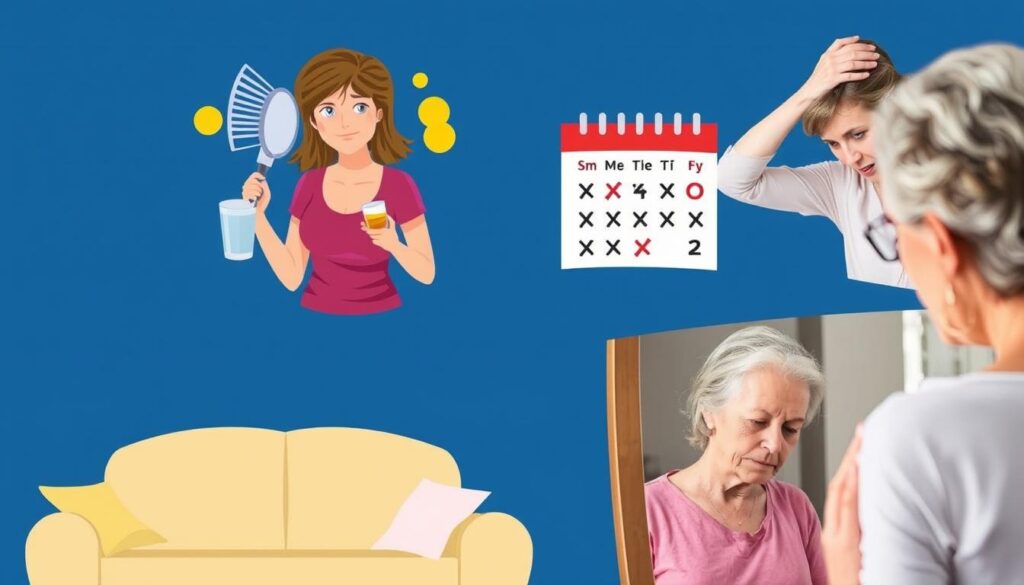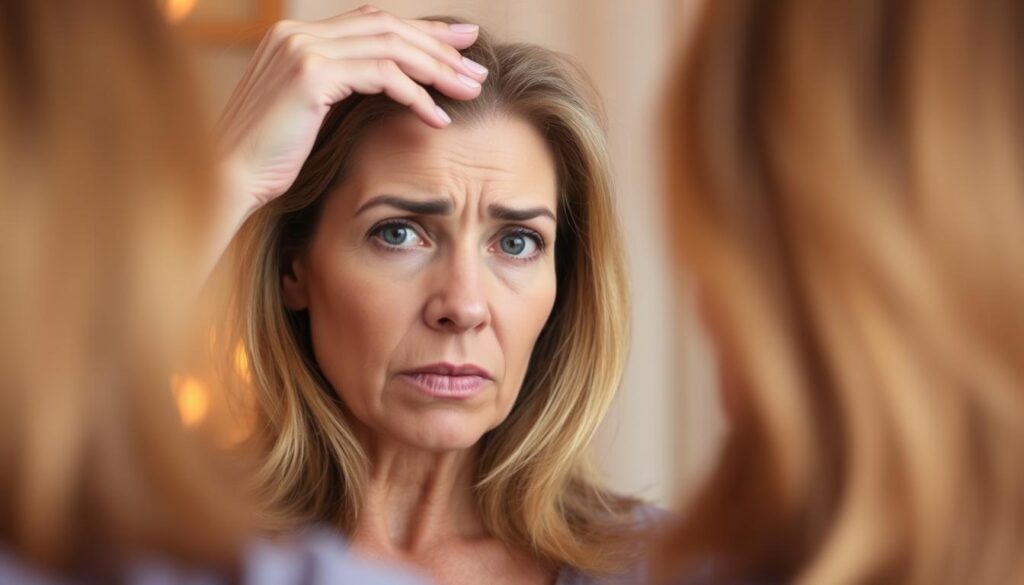Menopause is a phase in a woman’s life that can feel like a mystery. It’s hard to know if the changes you’re going through are normal or not. But don’t worry we’re here to help you understand the signs of this big change.
Going through menopause can be tough, but knowing what to expect can make a big difference. By learning about the common symptoms and body changes, you can take control of your health. This way, you can face this new chapter with confidence.
Key Takeaways
- Menopause is a natural transition that marks the end of a woman’s reproductive years.
- The average age of menopause in the United States is 51, but it can happen earlier due to certain medical conditions or treatments.
- Common symptoms of menopause include irregular periods, hot flashes, night sweats, mood swings, vaginal dryness, and loss of libido.
- Perimenopause, the transition period leading up to menopause, can last several years and bring its own set of hormonal changes.
- Understanding the signs of menopause can help women navigate this transition with greater ease and make informed decisions about their health.
What is Menopause?
Menopause is a natural change that marks the end of a woman’s ability to have children. It happens when the ovaries stop making eggs and the hormones estrogen and progesterone. This leads to the end of monthly periods. Most women in the U.S. reach menopause around 51 years old, but it can start in the 40s or 50s.
Defining Menopause
Menopause is when a woman hasn’t had a period for 12 months straight and isn’t pregnant or going through another condition that stops periods. This marks the end of her ability to have children and the start of a new life stage.
During menopause, changes in hormones can cause symptoms like irregular menstrual cycles, hot flashes, night sweats, and mood changes. Knowing about menopause and its signs can help women go through this change better.

Menopause is a normal part of aging and not a disease. It’s a time in a woman’s life when her menstrual periods stop, and she is no longer able to get pregnant.
How do I know if I’m in menopause?
A woman is in menopause when she hasn’t had a period for 12 months straight. This means her reproductive years are over. Her ovaries stop making eggs, and her cycles stop.
Menopause is different for everyone. Besides missing periods, women may also experience:
- Hot flashes
- Night sweats
- Vaginal dryness
- Mood changes
- Difficulty sleeping
Talk to your healthcare provider about any changes you notice. They can check if you’re going through menopause. They can also help with managing symptoms of menopause.
You’re in menopause when you haven’t had a period for 12 straight months and you aren’t pregnant or sick.
Menopause is a natural part of aging. It happens as estrogen levels drop. Most women reach menopause around 51 years old. But it can start in the 30s or late 50s.

Knowing about signs of menopause and symptoms of menopause helps women handle this big change. With the right support from healthcare providers, women can get through it.
Common Symptoms of Menopause
Women going through menopause often face physical and emotional changes. These include irregular periods, hot flashes, night sweats, and vaginal dryness.
Irregular periods are one of the first signs of menopause. This happens as the ovaries make less estrogen. Hot flashes and night sweats come from changing hormone levels and can be uncomfortable. Vaginal dryness, caused by less estrogen, can make being intimate hard.
- Irregular or missed periods
- Hot flashes
- Night sweats
- Vaginal dryness
- Mood swings
- Sleep problems
- Weight gain
Other symptoms include mood swings, sleep issues, and gaining weight. How bad and long these symptoms last can differ a lot from one woman to another. Knowing what menopause symptoms are like can help women go through this stage better.

Hot flashes can last for up to 14 years after menopause, and two-thirds of women may experience trouble with concentration and memory in the lead-up to menopause.
| Symptom | Prevalence | Duration |
|---|---|---|
| Hot Flashes | 75% of women | Up to 14 years |
| Vaginal Dryness | 50-60% of women | Ongoing |
| Sleep Problems | 60-70% of women | Varies |
| Mood Changes | 40-50% of women | Varies |
Perimenopause The Transition to Menopause
Perimenopause is the phase before menopause. It’s when a woman’s ovaries make less estrogen, causing hormone levels to go up and down. This can make periods irregular, with cycles changing in length and heaviness. Perimenopause can last from 2 to 8 years, with most women experiencing it for about 4 years.
Smoking can make perimenopause start earlier by 1 to 2 years. Women with a family history of early menopause might start it sooner too. Some cancer treatments, like chemotherapy or pelvic radiation, can also lead to early menopause.
If you notice your periods are very heavy, last over a week, or come too often, see a doctor. These are signs you might be in perimenopause. This phase can start in the mid-30s or late 50s, lasting about 4 years on average, but up to 8 years in some cases.
The drop in estrogen during perimenopause is the main cause of its symptoms. Even with hormone levels going down, you can still get pregnant during this time. Menopause is when you haven’t had a period for 12 months straight. If you go through menopause before age 40, it’s called premature menopause.

The first sign of perimenopause for many is irregular periods, transitioning from predictable cycles to spotting or missed periods.
Treatments for Menopausal Symptoms
Women going through menopause have many treatment options to ease symptoms. These range from hormone therapy to making lifestyle changes. The goal is to find what works best for each person.
Hormone Therapy
Hormone therapy replaces the estrogen and progesterone levels drop during menopause. It can help with hot flashes, vaginal dryness, and other symptoms. For women within 10 years of menopause, estrogen therapy is often recommended. It helps a lot and is considered safe.
Non-Hormonal Medications
For those who can’t or don’t want hormone therapy, non-hormonal meds can help. Options include antidepressants and seizure drugs that lessen hot flashes. Some bladder medications can also ease menopause symptoms.
Lifestyle Changes
Changing your lifestyle can also help manage menopause symptoms. Wearing light clothes, using cold packs, eating well, and exercising can help. Vaginal lubricants and pelvic floor exercises can also improve vaginal dryness and incontinence.
| Treatment Option | Effectiveness | Potential Risks |
|---|---|---|
| Hormone Therapy | Highly effective for hot flashes, vaginal dryness | Increased risk of heart disease, breast cancer with long-term use |
| Non-Hormonal Medications | Moderately effective for hot flashes, mood changes | Varied side effects depending on medication |
| Lifestyle Changes | Beneficial for various symptoms, improves overall health | No significant risks, easily implemented |
Women can find the right treatment or mix of treatments for their menopause symptoms. This helps improve their health and well-being.
Menopause and Age
Menopause is a natural change that usually happens between 45 and 55 years old. The average age of menopause in the U.S. is about 51 years. But, some women may go through it earlier or later than this.
Early menopause happens before 45 and affects about 5% of women. It can be due to medical treatments, genes, or unknown reasons. Premature menopause, before age 40, is rare, hitting less than 10% of women. It often comes from medical issues or treatments.
Knowing when menopause usually happens helps women get ready for the changes it brings. Late menopause, between 55-60, is linked to a lower risk of heart disease, osteoporosis, and stroke. It also means women might live longer.
| Menopause Type | Age Range | Prevalence |
|---|---|---|
| Average Menopause | 45-55 years | Majority of women |
| Early Menopause | Before 45 years | Approximately 5% of women |
| Premature Menopause | Before 40 years | Less than 10% of women |
| Late Menopause | 55-60 years | Smaller percentage of women |
Menopause is a natural step all women will go through. Knowing when it usually happens can help women be more ready for it.
Menopause and Health Risks
Women going through menopause face more health risks. These include heart disease, osteoporosis, urinary incontinence, sexual issues, and gaining weight. Knowing about these risks helps women stay healthy during this big change.
Cardiovascular Disease: When estrogen levels drop during menopause, heart and cardiovascular disease risk goes up. Women after menopause are more likely to get high blood pressure, high cholesterol, and atherosclerosis. These can cause heart attacks and strokes.
Osteoporosis: Women are more likely to get osteoporosis after menopause. This means their bones get weaker. Without estrogen, bone loss speeds up, making breaks and fractures more common. Exercise, a good diet, and hormone therapy can lower this risk.
Urinary Incontinence: After menopause, women often have urinary issues like urgency and stress incontinence. This is because estrogen levels drop. These problems can really affect life quality but can be managed with treatment.
Sexual Dysfunction: Menopause brings changes in hormones that can make vaginal dryness, lower libido, and sexual issues. Talking to a healthcare provider can help with these problems and keep relationships strong.
Weight Gain: Hormonal changes during and after menopause can lead to weight gain. This increases the risk of other health problems. A healthy lifestyle, like eating right and exercising, can help control weight and reduce risks.
Working with healthcare providers and being proactive can help women handle menopause’s health challenges. This way, they can stay healthy during this big change.
Understanding the health risks associated with menopause is crucial for women to take proactive steps in maintaining their well-being during this life-changing transition.
Menopause and Cultural Differences
Going through menopause is a deeply personal journey. It’s often influenced by a person’s race and culture. Studies show big differences in how women from various backgrounds handle this phase of life.
Some ethnic groups may feel menopause more intensely, with more symptoms. For example, Black women often report more severe hot flashes, sleep problems, and feelings of sadness than white women. How a community views and deals with menopause also matters.
- Rates of menopausal symptoms can vary significantly between different cultural backgrounds.
- The prevalence of specific menopausal symptoms can differ among women from diverse cultural backgrounds.
- Cultural differences may play a role in the utilization of medical treatments and alternative therapies for menopausal symptoms.
- The impact of menopause on quality of life may vary across cultural groups, influencing the overall well-being of women during this transitional phase.
These differences come from many factors, like stress, economic status, and experiences of discrimination. To give all women the best care during menopause, we must understand and tackle the effects of race and culture.
Black women are up to three times more likely than other ethnic groups to undergo a hysterectomy for fibroid tumors, leading to an earlier onset of menopause.
We’ve made good progress in learning about menopause, but we need more research and open talks. This ensures all women get the support and resources they need during this big change in life.
Conclusion
Menopause marks the end of a woman’s ability to have children. It can bring many changes and symptoms. Some women go through it easily, while others face challenges like hot flashes and mood changes. But, knowing about menopause overview and how to handle managing menopause symptoms can make a big difference.
Talking often with doctors and making healthy choices can help women deal with menopause. There are many ways to handle it, like trying hormone therapy, relaxing, or learning from age. Women can get through this big change with confidence and grace.
Menopause is a natural part of life for women. By facing it positively and with support, women can come out stronger and wiser. Let’s celebrate the strength and flexibility of women as they go through this change. It’s in these times that we learn the most about our inner strength.





